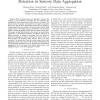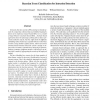98 search results - page 3 / 20 » Utilizing network features for privacy violation detection |
CCS
2004
ACM
13 years 10 months ago
2004
ACM
A network covert channel is a mechanism that can be used to leak information across a network in violation of a security policy and in a manner that can be difficult to detect. In...
WISA
2004
Springer
13 years 10 months ago
2004
Springer
In this paper, we, as well as Eskin, Lee, Stolfo [7] propose a method of prediction model. In their method, the program was characterized with both the order and the kind of system...
INFOCOM
2011
IEEE
12 years 8 months ago
2011
IEEE
—When wireless sensors are deployed to monitor the working or life conditions of people, the data collected and processed by these sensors may reveal privacy of people. The actua...
SUTC
2008
IEEE
13 years 11 months ago
2008
IEEE
Most of research efforts have elaborated on k-anonymity for location privacy. The general architecture for implementing k-anonymity is that there is one trusted server (referred t...
ACSAC
2003
IEEE
13 years 9 months ago
2003
IEEE
Intrusion detection systems (IDSs) attempt to identify attacks by comparing collected data to predefined signatures known to be malicious (misuse-based IDSs) or to a model of lega...


